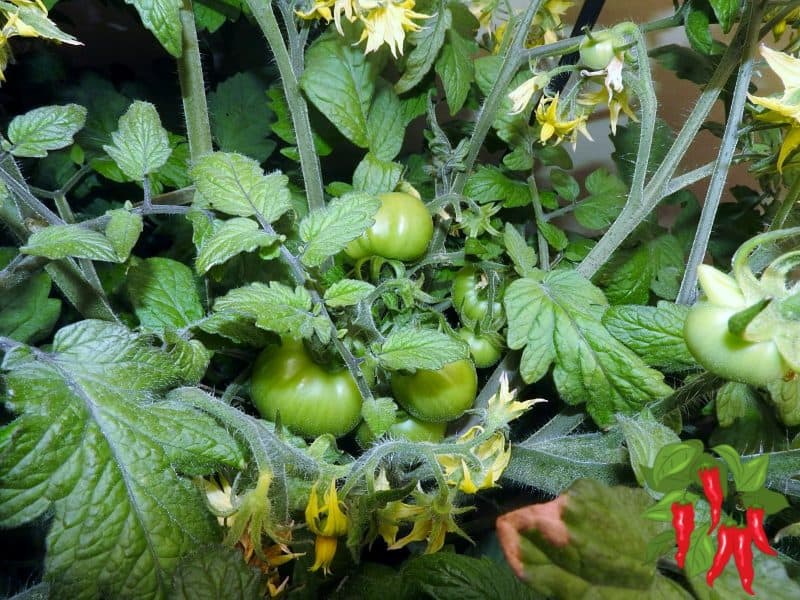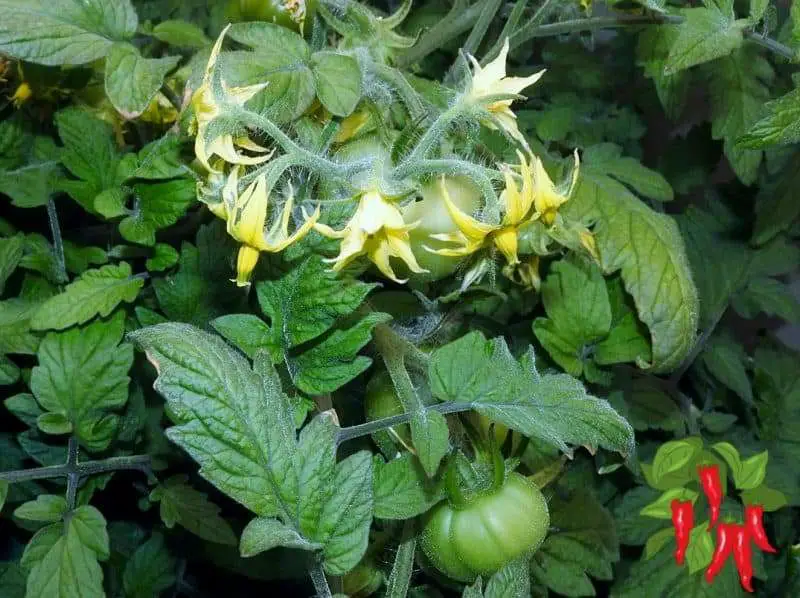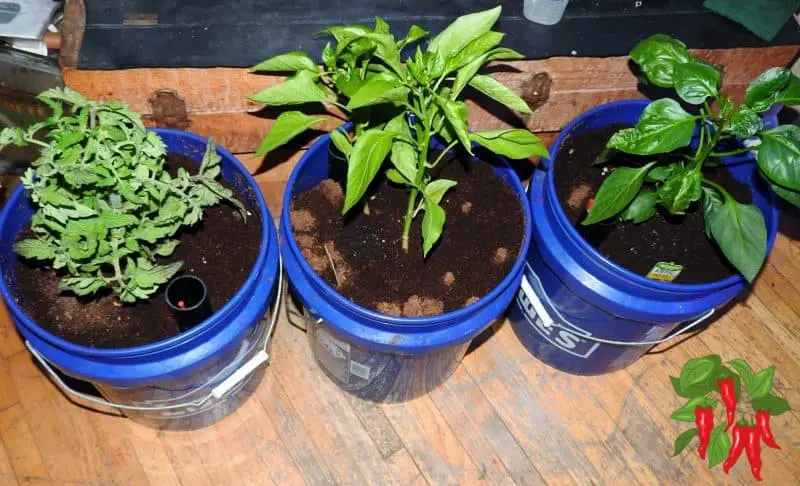This post contains affiliate links. If you buy something from one of our links we may earn a commission. Thanks

Have you thought about growing vegetables indoors year round? Are you wondering if it is even possible in an apartment? The good news is you can!
Growing Vegetables Indoors Key Takeaways:
- Growing vegetables indoors year round allows you to have a continuous supply of fresh produce right in your home.
- This requires selecting suitable plants, ensuring adequate light either through sunny windows or grow lights
- Regularly watering, and using the right soil or hydroponic system allows for nurturing your veggies to maturity.
Growing Vegetables Indoors Year Round
Who wouldn’t love a fresh crunch of lettuce or a juicy tomato straight from the plant, and that too, any time of the year?
The idea of growing vegetables indoors year round is not just exciting but also a step towards self-sustainability.
Whether you reside in a bustling city with no garden space or in a snowy town where winters seem endless, indoor gardening is your gateway to fresh vegetables right at your fingertips.
This guide is here to sprinkle some greenery into your indoors, making home-grown vegetables a reality, no matter the season.
You can grow many types of vegetables indoors all year round. Do you love the taste of fresh vegetables, but don’t have the time or space to garden outdoors?
Well, you’re in luck! We will give you some helpful tips and tricks for growing vegetables indoors.
We share some of the best vegetables to grow indoors. So, whether you are a beginner or an experienced gardener, read on for some helpful advice!
Are Indoor Gardens Worth It?
Are indoor gardens worth it? The answer may depend on your reasons for growing plants indoors.
Some people do it for the challenge, while others enjoy the process of nurturing their plants.
And of course, there are those who simply love fresh vegetables and want to have a never-ending supply!
No matter what your motivation is, growing vegetables indoors year round can be a fun and rewarding experience.
What is the easiest plant to grow indoors?
One of the great things about growing plants indoors is that you can grow just about anything! However, some plants are easier to grow than others.
If you are a beginner, we recommend starting with a plant that is easy to care for and doesn’t require too much sunlight.
Some of our favorite easy-to-grow plants include herbs (such as basil, mint, and cilantro), and leafy greens (such as spinach and kale).
Once you have mastered these basics, you can move on to more challenging plants.
Lettuce Is A Very Easy Plant To Grow Indoors
Lettuce is a great plant to grow indoors because it doesn’t require a lot of space or sunlight.
Plus, it’s relatively easy to care for and can be harvested in just a few weeks. If you are new to indoor gardening, we recommend starting with lettuce.
It’s a forgiving plant, so even if you make a few mistakes, your lettuce will still turn out delicious!
When it comes to growing vegetables indoors year round lettuce is one of the easiest and yields faster than most other crops.
And once you’ve mastered growing lettuce, you can move on to other leafy greens like spinach and kale.
So what are you waiting for? Get started today and enjoy fresh, homegrown lettuce all year round!
Some Tips For Growing Vegetables Indoors Year Round
Here are some tips for growing vegetables indoors:
- Choose the right plants. Not all plants will do well indoors, so it’s important to choose ones that are specifically designed for indoor gardening.
- Give them enough light. Many indoor plants need 12 hours of sunlight per day, so make sure you place them in a bright spot. If you don’t have enough natural light, you can supplement with grow lights.
- Water them regularly. Indoor plants generally need to be watered more often than outdoor plants because they tend to dry out faster. Make sure you check the soil before watering and only water when the soil is dry to the touch.
- Fertilize them. Fertilizing your indoor plants will help them grow strong and healthy.
What Are The Best Vegetables To Grow Indoors?
One of the great things about growing vegetables indoors is that you can do it all year round! This means you can enjoy fresh, homegrown produce even in the middle of winter.
Some of the best vegetables to grow indoors include lettuce, microgreens, leafy greens, herbs, and root vegetables.
So whether you are a beginner or an experienced gardener, read on for some helpful advice!
The Benefits Of Growing Vegetables Indoors
There are many benefits to growing vegetables indoors, including year-round access to fresh produce, and the ability to grow plants that may not do well in your climate.
One of the main benefits is that you can enjoy fresh produce all year round even though you don’t have an outdoor garden.
And in most parts of the country outdoor gardens are seasonal but indoor gardening is year-round.
Another benefit is that it doesn’t require as much space as outdoor methods. Additionally, it’s much easier to control your environment indoors.
Plants that don’t grow well outdoors in your climate because it is too hot or cold or the growing season is too short can often thrive indoors.
Can I Grow Vegetables Indoors Year-Round?
The answer is yes, but there are a few things to keep in mind. Growing vegetables indoors year-round requires some planning and preparation, but it can be done.
Here are a few tips to get you started:
- Choose the right location. Make sure you have enough light and ventilation for your plants. If possible, place them near a south-facing window.
- Get the right supplies. You’ll need pots, soil, fertilizer, and seeds or seedlings.
- Start with easy plants. Some good options include lettuce, greens, and herbs.
- Tomatoes and peppers are good choices for more experienced gardeners.
- Be prepared for pests. Indoor plants can still attract bugs like aphids and spider mites.
Growing Cucumbers Indoors
If you’re looking to add some fresh veggies to your indoor garden, cucumbers are a great option! These hardy plants can grow in a variety of conditions, making them perfect for growing indoors.
Here are a few tips for growing cucumbers indoors:
- Choose a pot that is at least 12 inches wide and has drainage holes.
- Fill the pot with light, well-draining soil.
- Water the plant regularly, but don’t overdo it – cucumbers like moist soil, but not soggy conditions.
- Place the pot in an area that gets direct sunlight for at least six hours per day.
- When the plant starts to produce fruit, you can help support the cucumbers by tying them to a trellis or other support.
- Try growing bush cucumber plants they are much easier to contain.
With a little care, you can enjoy fresh cucumbers from your indoor garden all year round!
How Do You Grow An Indoor Garden For The Winter?
What if you want to enjoy the fruits (and vegetables) of your labor year-round? Or, what if you live in an apartment and don’t have access to an outdoor space?
You can still be growing a winter garden indoors! Here are some tips on growing vegetables indoors during the winter months.
With a little creativity and effort, you can enjoy homegrown veggies all winter long. These tips will help you get started:
- Find a sunny spot: Most vegetables need at least six hours of sunlight per day, so find a spot in your home that gets plenty of natural light.
- If you don’t have a south-facing window, you can supplement with grow lights.
- Start with small plants: Don’t try to grow large plants indoors – they won’t have enough space to thrive.
- Stick with smaller varieties that will do well in containers, such as cherry tomatoes, lettuce, and herbs.
- Many popular vegetables are available in bush form and are much easier to grow indoors.
- Choose the right containers: Make sure your containers have drainage holes so that excess water can escape.
- Don’t let your plants sit in water, which can lead to root rot.
- Give them room to breathe: Once your plants start growing, they’ll need more space than they did when they were seedlings.
- Be sure to transplant them into larger pots or planters so they have room to reach their full potential.
With a little care and attention, you can with cool weather crops all winter long indoors.
Can You Grow Tomatoes All Year Round?
Can you grow tomatoes indoors in the winter? Yes, you can grow tomatoes indoors all year round with the right setup.

You will need a very sunny spot or a grow light, and a tomato plant. With these three things, you can have fresh tomatoes any time of year.
So if you are looking for a way to get fresh vegetables all year round, growing them indoors is the way to go.
Just make sure you have the right setup and you will enjoy delicious homegrown vegetables any time of year.
Can You Grow Tomatoes Indoors In The Winter?
The short answer is yes, you can grow tomatoes indoors in the winter. However, there are a few things to consider before starting your indoor tomato garden.
First, you’ll need to choose a tomato variety that is well-suited for growing indoors. There are many determinate and dwarf varieties of tomatoes that are ideal for growing in small spaces.
Second, you’ll need to make sure you have enough light. Tomato plants need at least six hours of direct sunlight per day in order to produce fruit. If you don’t have that you may need to invest in LED grow lights.
With proper care, you can enjoy fresh tomatoes from your indoor garden all year long! Check out my blog for more tips.
Hydroponic Vegetables Vs Container Plants Or Soil
The first thing you need to do when growing vegetables indoors is to decide which method you will use.
There are three common methods for growing vegetables indoors: hydroponics, containers, and soil. Each method has its own set of pros and cons that you need to consider before making a decision.
Hydroponics
Hydroponics is a method of growing plants in water without using any soil. The biggest advantage of hydroponics is that it requires very little space.
Generally, plants grow much faster and yield sooner. They often produce more too.
You can easily set up a hydroponic system in a small room or closet.
Another benefit of hydroponics is that since it eliminates soil the need for weeding and pest control is much less. Many soil-borne diseases are eliminated as well.
However, one downside of hydroponics is that it requires more attention to detail than other methods of growing vegetables.
Just so you know growing hydroponic vegetables indoors is my preferred way to grow. DWC or deep water culture is ideal for larger plants like tomatoes.
Container Gardens

Containers are another popular method for growing vegetables indoors. One advantage of using containers is that they can be moved around easily.
This means that you can grow vegetables in any location, regardless of sunlight or temperature.
Another benefit of containers is that they allow you to control the amount of soil and water your plants receive.
However, one downside of growing vegetables in containers is that they require more frequent watering than other methods.
Soil
Soil is the traditional method for growing plants, and it’s also the easiest method for growing vegetables indoors.
Garden soil has largely been replaced with soilless peat-based mixes. I really do not think it is suitable for growing indoors. It can harbor bugs and diseases and it compacts easily.
My advice is don’t try to use it indoors. Use potting soil or coco indoors and keep garden soil out in the garden where it belongs.
One advantage of soil is that it doesn’t require as much attention as other methods. You can set up a soil-based system and then forget about it for weeks at a time.
Another benefit of soil is that it’s very forgiving. If you make a mistake, your plants will likely recover.
However, one downside of growing vegetables in soil is that it requires more space than other methods.
Once you’ve decided which method you want to use, you need to choose the right location for your plants.
The amount of sunlight your plants receive is one of the most important factors in determining where to place them.
If you’re using containers, you can move them around to ensure that they receive the right amount of sunlight. If you’re using hydroponics this is harder to do.
Most apartments will require supplemental lighting to grow vegetables. LED grow lights will allow your plants to develop their true potential.
Therefore being able to move plants around is much less important when you use LED grow lights.
FAQs
Diving into the realm of indoor vegetable gardening might prompt a handful of questions.
It’s a different ball game compared to traditional outdoor gardening, after all.
We’ve curated a set of frequently asked questions to ease your green thumb into the cozy indoors, ensuring your venture into growing vegetables indoors year-round is fruitful and enjoyable.
Q. What vegetables are easiest to grow indoors?
A. Leafy greens like lettuce, spinach, and kale are among the easiest to grow indoors.
Herbs such as basil, mint, and cilantro also thrive well inside. These plants don’t require a lot of sunlight and are great for beginners.
Q. How do I ensure my indoor vegetables receive enough light?
A. Placing your plants near south-facing windows can provide them with natural light.
However, if that’s not sufficient or available, investing in grow lights, especially LED grow lights, can provide the necessary light exposure to your plants.
Q. How often should I water my indoor vegetables?
A. Indoor plants generally need more frequent watering as they dry out faster.
It’s crucial to check the soil before watering. If it feels dry to the touch, it’s time to water.
Ensuring your containers have good drainage is also key to preventing waterlogging.
Q. Can I grow root vegetables indoors?
A. Yes, you can grow root vegetables like carrots, radishes, and beets indoors. They require deeper containers to accommodate the growing roots and adequate light to thrive. With the right setup, you can enjoy root vegetables grown indoors year round.
Indoor vegetable gardening is a journey filled with learning, growing, and of course, delicious fresh produce.
Each leaf you grow and every vegetable you harvest brings the satisfaction of self-sufficiency and the joy of gardening, right in the comfort of your home.
Final Thoughts On Growing Vegetables Indoors Year Round
Overall, there are a few different methods that you can use growing vegetables indoors year round. Each method has its own advantages and disadvantages.
You will need to decide which method is best for you based on your needs and preferences. Once you have chosen a method, be sure to choose the right location for your plants.
With a little bit of planning and effort, you can successfully grow vegetables indoors year-round.
Here is some more info about hydroponics: https://en.wikipedia.org/wiki/Hydroponics






